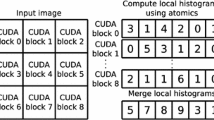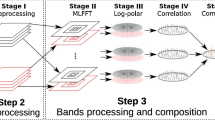Abstract
Image registration is a common task in remote sensing, consisting in aligning different images of the same scene. In the particular case of hyperspectral images, the exploitation not only of the spatial information contained in the image but also of the spectral information helps to improve the registration. An example of registration method exploiting all the information contained in the images is HSI–KAZE, which is based on feature detection and detects keypoints using nonlinear diffusion filtering. The algorithm is oriented toward extreme situations in which the images are very different in terms of scale, rotation and displacement. In this paper, an efficient implementation of the HSI–KAZE algorithm on GPU using CUDA is proposed. A detailed analysis of the implementation as well as a performance comparison to an OpenMP multicore implementation is also presented. The resulting algorithm is suitable for on-board processing of high-resolution images.



Similar content being viewed by others
References
Agrawal M, Konolige K, Blas MR (2008) Censure: center surround extremas for realtime feature detection and matching. In: European Conference on Computer Vision, Springer, pp 102–115
Alcantarilla PF, Bartoli A, Davison AJ (2012) KAZE features. In: European Conference on Computer Vision, Springer, pp 214–227
Alcantarilla PF, Nuevo J, Bartoli A (2011) Fast explicit diffusion for accelerated features in nonlinear scale spaces. IEEE Trans Pattern Anal Mach Intell 34(7):1281–1298
Bascoy GP, Quesada-Barriuso P, Heras BD, Argüello F (2019) Wavelet-based multicomponent denoising profile for the classification of hyperspectral images. IEEE J Sel Top Appl Earth Obs Remote Sens 12(2):722–733. https://doi.org/10.1109/JSTARS.2019.2892990
Fan Z, Vetter C, Guetter C, Yu D, Westermann R, Kaufman A, Xu C (2008) Optimized GPU implementation of learning-based non-rigid multi-modal registration. In: Medical imaging. International Society for Optics and Photonics, pp 69142Y–69142Y
Garcia V, Debreuve E, Barlaud M (2008) Fast k nearest neighbor search using GPU. In: 2008 IEEE Computer Society Conference on Computer Vision and Pattern Recognition Workshops, IEEE, pp 1–6
Hasan M, Jia X, Robles-Kelly A, Zhou J, Pickering MR (2010) Multi-spectral remote sensing image registration via spatial relationship analysis on SIFT keypoints. In: Geoscience and Remote Sensing Symposium (IGARSS), 2010 IEEE International, IEEE, pp 1011–1014
Li Q, Wang G, Liu J, Chen S (2009) Robust scale-invariant feature matching for remote sensing image registration. IEEE Geosci Remote Sens Lett 6(2):287–291
Lowe A, Harrison N, French AP (2017) Hyperspectral image analysis techniques for the detection and classification of the early onset of plant disease and stress. Plant Methods 13(1):80
Lowe DG (2004) Distinctive image features from scale-invariant keypoints. Int J Comput Vis 60(2):91–110
Mehmet F, Yardimci Y, Temlzel A et al (2009) Registration of multispectral satellite images with orientation-restricted SIFT. In: Geoscience and Remote Sensing Symposium, 2009 IEEE International, IGARSS 2009, vol. 3. IEEE, pp III–243
Munir M, Wilson DI, Yu W, Young B (2018) An evaluation of hyperspectral imaging for characterising milk powders. J Food Eng 221:1–10
NVIDIA: CUB Library (2018). https://nvlabs.github.io/cub/. Accessed 19 Sept 2019
NVIDIA: CUDA C Best Practices Guide (2019). https://docs.nvidia.com/pdf/CUDA_C_Best_Practices_Guide.pdf. Accessed 19 Sept 2019
NVIDIA: NVIDIA Performance Primitives (NPP) v10.1.1 User’s Guide (2019). https://docs.nvidia.com/cuda/archive/10.1/npp/index.html. Accessed 19 Sept 2019
Ordóñez Á, Argüello F, Heras BD (2018) Alignment of hyperspectral images using KAZE features. Remote Sens 10(5):756. https://doi.org/10.3390/rs10050756
Ordóñez Á, Argüello F, Heras BD (2017) GPU accelerated FFT-based registration of hyperspectral scenes. IEEE J Sel Top Appl Earth Obs Remote Sens 10(11):4869–4878
Ramkumar B, Laber R, Bojinov H, Hegde RS (2019) GPU acceleration of the KAZE image feature extraction algorithm. J Real Time Image Process 11:1–4
Sah S, Vanek J, Roh Y, Wasnik R (2012) GPU accelerated real time rotation, scale and translation invariant image registration method. In: Campilho A, Kamel M (eds) Image analysis and recognition. Springer, Berlin, Heidelberg, pp 224–233
Sanders J, Kandrot E (2010) CUDA by example: an introduction to general-purpose GPU programming. Addison-Wesley Professional, Boston
Shams R, Sadeghi P, Kennedy R, Hartley R (2010) Parallel computation of mutual information on the GPU with application to real-time registration of 3D medical images. Comput Methods Programs Biomed 99(2):133–146
Vince R, More SS (2018) Hyperspectral imaging for detection of Parkinson’s disease. US Patent App. 10/098,540
Yi Z, Zhiguo C, Yang X (2008) Multi-spectral remote image registration based on SIFT. Electron Lett 44(2):107–108
Zhang Y, Zhou P, Ren Y, Zou Z (2014) GPU-accelerated large-size VHR images registration via coarse-to-fine matching. Comput Geosci 66:54–65
Zitova B, Flusser J (2003) Image registration methods: a survey. Image Vis Comput 21(11):977–1000
Acknowledgements
This work was supported in part by the Consellería de Educación, Universidade e Formación Profesional [Grant Nos. GRC2014/008, ED431C 2018/19 and ED431G/08] and Ministerio de Economía y Empresa, Government of Spain [grant number TIN2016-76373-P] and by Junta de Castilla y Leon - ERDF (PROPHET Project) [Grant No. VA082P17]. All are cofunded by the European Regional Development Fund (ERDF). The work of Álvaro Ordóñez was also supported by Ministerio de Ciencia, Innovación y Universidades, Government of Spain, under a FPU Grant [Grant Nos. FPU16/03537 and EST18/00602].
Author information
Authors and Affiliations
Corresponding author
Additional information
Publisher's Note
Springer Nature remains neutral with regard to jurisdictional claims in published maps and institutional affiliations.
Rights and permissions
About this article
Cite this article
Ordóñez, Á., Argüello, F., Heras, D.B. et al. GPU-accelerated registration of hyperspectral images using KAZE features. J Supercomput 76, 9478–9492 (2020). https://doi.org/10.1007/s11227-020-03214-0
Published:
Issue Date:
DOI: https://doi.org/10.1007/s11227-020-03214-0




